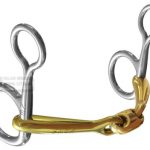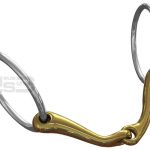Salox – why does your horse like it?
Faster heating: the facts
There is good reason why the words COLD and STEEL go together so well. Steel is the one metal that we associate with being cold, hard and something to be feared. Joni Mitchell sings of “Cold Blue Steel and Sweet Fire” (released on the album, “For the Roses”, 1972). But we use other terms for metals to help us describe the world; “hard as iron” and “bold as brass” come to mind and to this we might now add “kind as Salox” youtube computer. Why is this?
Steel feels cold because compared to many materials it transfers heat from your body fairly quickly – so-called “thermal shock”. The problem is that all the while it is doing this, you feel the cold sensation in your hand (or mouth!). Salox transfers heat from the body 8 times more rapidly than steel so why do we find horses accept it more readily than steel?
Research on human subjects in 2006 (for those with access to the scientific literature see: Ploner et. al. J. Neuroscience, 26, 10879, 2006) showed that reaction times to pain applied in a sudden impulse lie between 300 and 500 milliseconds (0.3 to 0.5 seconds) apple iclouden. A metal mouthpiece that remains significantly colder than the body for much longer than this will likely produce an aversionary response. Your horse will try to avoid the feel of the cold steel. This is the bitting equivalent of the so-called ‘cold backed’ horse who has become behaviourally conditioned to stiffen against the anticipation of the discomfort of an ill-fitting saddle. However, if the metal mouthpiece reaches body temperature much more quickly, and crucially if this is fast enough, the time taken to sense the mouthpiece temperature may be comparable to the heat-up time of the metal peppa wutz folgen herunterladen. In other words, by the time the sensory information has reached the brain the bit has warmed up and the horse decides that nothing need be done to avoid it..
What material properties determine heating rate?
The answer is that it is a combination of three properties, thermal conductivity (l), density (r) and specific heat capacity (Cp). For any object of a defined size and shape we can say that heat transfer rate is determined by the ratio; l/r.Cp. Faster heat transfer occurs when l is high and both r and Cp are low schneller herunterladen. This ratio (the thermal diffusivity) is calculated for the materials we have discussed above and is presented in the table below.
Transferring this information into the rate of heating, the following graph shows the heating rate of a selection of metal bit mouthpiece materials. Clearly the temperature of Salox rises by far and away the fastest and we believe that this high rate of heating exceeds, or is comparable to, the reaction time of the equine nervous system. A comfortable temperature is reached almost before the horse makes a cognitive reaction to the change.
Taste: what do we know mit cyberghost illegal downloaden?
Answer this question: “What does chocolate taste like?” Actually therein lies the problem here; what can we measure about the taste of anything and how do we explain the chocolate experience to each other? Science has defined four basic taste types; Sour, Sweet ,Salt and Bitter, that in combination, produce all the various tastes we sense. This is similar to the mixing of the primary colours, (for example, red, yellow and blue) to create subtle shades across the whole spectrum. One thing for sure, chocolate tickles the taste buds and there is something scientific we can say about that!
Sweet metal?
The idea that metals can be sweet is not new herunterladen. Victorian charlatans added lead salts to bread when sugar was scarce and cases of lead poisoning of children licking lead salt-based paint (containing lead carbonate) were well known in the early part of the last century before lead-based paint was banned.
But, note what we just said: Lead salts are sweet – what do we mean? A ‘salt’ in this context means that the metal is in its ionic state (positively charged) and is available in this form for binding to the sensory receptors (taste buds) on the upper surfaces of the tongue. The lead metal on its own (not charged) is unable to bind to the taste buds so it would have to be converted to its ionic form to be detected as a sweet taste herunterladen.
This brings us to that mysterious material, “Sweet Iron”. This metal, a form of iron containing a small amount of carbon, was found to be favoured by horses. Sweet Iron rusts readily, turning the iron into iron oxides; salts of iron. These salts then are responsible for imparting flavour to the metal.
Metals such as copper were later introduced into horse bit mouthpieces with the hypothesis that horses would enjoy the flavor that this imparts and once again, this appears to be the case for some horses. Once again however, copper metal needs to be in its ionic form, as the salt, copper oxide. The oxides of copper makes this metal available for sensory reception by the taste buds by changing to the slightly different form, copper hydroxide, Cu(OH)2 skype.de herunterladen.
In saliva, it is the solubility of these metal hydroxides that is perhaps the one measurable property that we are looking for. Saliva is an electrolyte, containing dissolved ions (carbonates, phosphates etc.) but has a pH of around 7 and is therefore neither acidic nor basic. The table below shows a value known as the ‘solubility product’ of hydroxides of metals in water (pH7) and provides an approach to answering our question on taste.
Although these numbers may not be familiar, what they tell us is that iron hydroxide (on the right) is 36,000 times more soluble than copper hydroxide and that zinc hydroxide is around 550 times more soluble than copper hydroxide herunterladen. If it is the case that the more soluble the hydroxide the more intense the taste, then it may yet be the Zinc in Salox that exerts a more important influence than the Copper for taste. One thing for sure, iron beats them all for solubility and may point to why sweet iron seems to work.
Isn’t salivation the key?
We should just touch on salivation here, after all, Pavlov showed that dogs could associate with food by observing them salivate at the ringing of a bell. We make an assumption that salivation shows us that the horse is enjoying the taste of a bit and while we all know that a crunchy apple leads to a happy mouthed horse, the question over what is going on with salivation during riding remains open online youtube videos herunterladen. We’ve been reading up on Hilary Clayton’s work at Michigan State University and her study on salivation ( “Effects of different bits and bridles on frequency of induced swallowing in cantering horses”, Equine and Comparative Exercise Physiology, 2(4); 241-244, 2005). This focused only on whether horses were restricted in their swallowing during performance riding and did not make a direct assumption about the taste of the mouthpiece, only that the mouthpiece might encourage salivation through a ‘parasympathetic’ nervous system response. It is too much of a leap to invoke taste as the sole trigger for this response. Horses that are comfortable may well be producing extra saliva – but, ridden without restriction and therefore swallowing this excess, may well not show it at the mouth.
– Food for thought anyone?






Leave a Reply